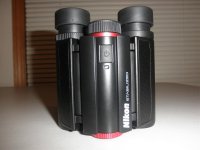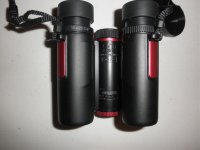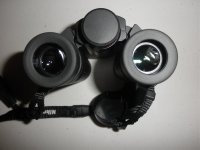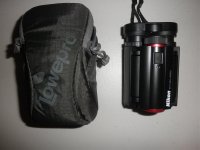I have had a pair of the new Nikon 10x25 Image Stabilized binoculars for a while and I must say I am quite impressed. In my opinion these could well be some competition for the alpha compacts like the Swarovski CL-P and the Zeiss Victory 10x25 mainly because of the IS system. The optics on these are very comparable plus it has the added advantage of the IS which increases resolution at least 30% at 10x according to Kimmo's tests. The FOV on these are 5.6 degrees which is equal to the Swarovski but slightly smaller than the Zeiss which is 6 degrees. The edges are sharp and it has a big sweet spot similar to the CL-P. The Zeiss of course has a bigger FOV but not as big of sweet spot nor is it as sharp on the edges. The Nikon's optics remind me of the LX 10x25 and as far as glare control they are excellent for such a small binocular. Nikon must have blackened the optical tubes very well. The IS system on a binocular of this size and weight is a real advantage because a smaller lighter binocular can be harder to hold steady. You can without a doubt see more detail with these than you can with ANY regular non-IS 10x25 compact binocular including the alphas. The IS a lens-shift system which is the newer system like used in the newer Canon IS models and it works as well as the Canons with no artifacts that I can see and seems to stabilize just as effectively as the Canons meaning rock steady like a tripod. The stabilization stays on for 10 minutes unless you shut it off and then it shuts off by itself so that is a nice feature. Also, it uses one light weight CR2 lithium battery which lasts 3 1/2 hours and doesn't add much to the weight of the binocular which is 14 oz. so it is few ounces heavier than the Alpha compacts which isn't bad for an IS binocular. It is double hinge so it folds down small like the CL-P and it is about the same size as the Zeiss Victory and the Swarovski Cl-P when folded open. It is MIC but it seems very high quality with a very smooth focuser with just about the right amount of tension. The diopter is on the right ocular and it has enough tension that it doesn't move easily. The eye cups work well and offer three positions and usually I have problems with the eye cups not being long enough for the eye relief which results in black outs but these worked perfectly for me with no blackouts. So if you have shallow eye sockets like I do these will work for you! The strap is well sized for the binocular and the rain guard is one piece and it only fits when the binocular is folded which isn't a bad idea because the foldable ones can be problematic when you fold the binoculars. The case is pretty unusable being a velvet bag which doesn't offer much protection but I replaced it with a Lowepro Dashpoint 20 which fits it perfectly. Overall I think the Nikon 10x25 IS is unique in the marketplace being the only IS compact binocular I know of that looks like a compact binocular and performs like the mostly bigger Canon IS models. There are the Fujinon Techno-Stabi models, but they are only offered in 12x and 16x and have a very small FOV which doesn't work well for birding. I have tried almost all the compact binoculars including the alphas in 8x20, 8x25 and 10x25 and I find these to be the easiest to use and most comfortable with easier eye placement and the highest performing especially in regard to resolution because of the IS system. If you think about it with a compact you are biking or hiking or running or doing something active and then when you stop to use your binoculars it is really nice to have the IS feature to stabilize the view. Give them a try you might be surprised! I was.
https://www.nikon-image.com/products/sportoptics/stabilized_binoculars/10x25_stabilized/
https://www.ebay.com/itm/303702428564
https://www.ebay.com/itm/124349503514
https://www.ebay.com/itm/303702432184
https://www.nikon-image.com/products/sportoptics/stabilized_binoculars/10x25_stabilized/
https://www.ebay.com/itm/303702428564
https://www.ebay.com/itm/124349503514
https://www.ebay.com/itm/303702432184
Attachments
Last edited:











